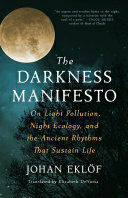
"How much light is too much light? Satellite pictures show our planet as a brightly glowing orb, and in our era of constant illumination, light pollution has become a major issue. The world's flora and fauna have evolved to operate in the natural cycle of day and night. But in the last 150 years, we have extended our day-and in doing so have forced out the inhabitants of the night and disrupted the circadian rhythms necessary to sustain all living things, including ourselves. In this persuasive, well-researched book, Swedish conservationist Johan Eklèof urges us to appreciate natural darkness, its creatures, and its unique benefits. He ponders the beauties of the night sky, traces the swift dives of keen-eyed owls, and shows us the bioluminescent creatures of the deepest oceans. As a devoted friend of the night, Eklèof reveals the startling domino effect of diminishing darkness: insects, dumbfounded by streetlamps, failing to reproduce; birds blinded and bewildered by artificial lights; and bats starving as they wait in vain for insects that only come out in the dark. For humans, light-induced sleep disturbances impact our hormones and weight, and can exacerbate chronic stress and depression. Streetlamps, floodlights, and the ever more pervasive and searingly bright LED lights are altering entire ecosystems, and scientists are only just beginning to understand the long-term effects. Educational, eye-opening, and ultimately encouraging, The Darkness Manifesto outlines simple steps that we can take to benefit ourselves and the planet. In order to ensure a bright future, we must embrace the darkness."--